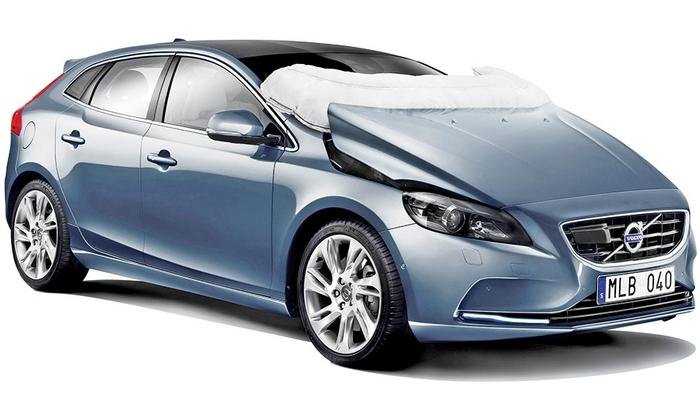New Airbag Devices Cushion Crash Impacts by Deploying Outside Vehicles

Airbag makers aren't quite ready to go that far, but they have developed a new generation of airbags designed to buffer a vehicle's exterior.
Some of these technologies may prove impractical. But they hint at a clean-sheet approach to safety that could shake up a segment that was starting to look mature.
Moreover, external airbags passed their initial test in Europe, where they are used to protect pedestrians in head-on collisions. The Volvo V40, for example, features an Autoliv-designed airbag that is stored under the vehicle's hood and deploys in a collision with a pedestrian to swaddle the A-pillars and windshield wipers. The rear of the vehicle's hood is lifted to cushion the impact for the pedestrian.
Now, suppliers are considering more ambitious designs. Last month, ZF TRW showcased an external side airbag that would protect cars that get T-boned by another vehicle. Three years ago, ZF TRW participated in a research consortium that built a prototype airbag stowed in the frame rails beneath the doors.
With a volume of 200 liters, the airbag was about twice the size of a conventional side curtain, so the research team used two inflators to fill it. And because the large airbag required extra time to inflate, it was designed to deploy just before the collision.
After a series of crash tests, the researchers concluded that its airbag could reduce the force of a side collision by 30 percent, said Steve Peterson, ZF TRW's director of global systems engineering for occupant safety.
"It's definitely intriguing," Peterson said. "I think it could make sense -- especially for a small car that sits low to the ground."
There are some hurdles. An external airbag must withstand the corrosive effect of rain, snow, dirt and road salt. And because the bag deploys before a collision, its controller requires foolproof software to avoid false alarms.
"There are a lot of people in the industry working on that," Peterson noted. "The technology is getting better."
TRW also has worked with automakers to see how such an airbag might be packaged in the vehicle. Spanish automaker Seat, a subsidiary of Volkswagen AG, was a member of the research consortium that developed the prototype.
"We did a fair amount of work with the automakers to see if we need a bag as big as the one we demonstrated," Peterson said. "That work is still going on. It's a big challenge."
Other safety devices may prove more practical. Peterson said the researchers also studied a pyrotechnic device that pushes the seat away from the door in a side-impact collision. A side airbag would deploy to fill the extra space between seat and door.
Yet another idea is a hollow steel panel that fits across the door. During a collision, an inflator balloons it into a 3-inch-wide tube to reinforce the door panel. Autoliv also has tested similar devices in A-pillars and front frame rails.
As automakers develop self- driven vehicles that can brake automatically, airbags may be no longer needed. But that day is a decade or more away.
And as cars get smaller and lighter, they will be more vulnerable to side-impact collisions with pickups and full-size SUVs. So it seems likely that automakers will take a long, hard look at external airbags and other devices to cushion the blow.
Related News


